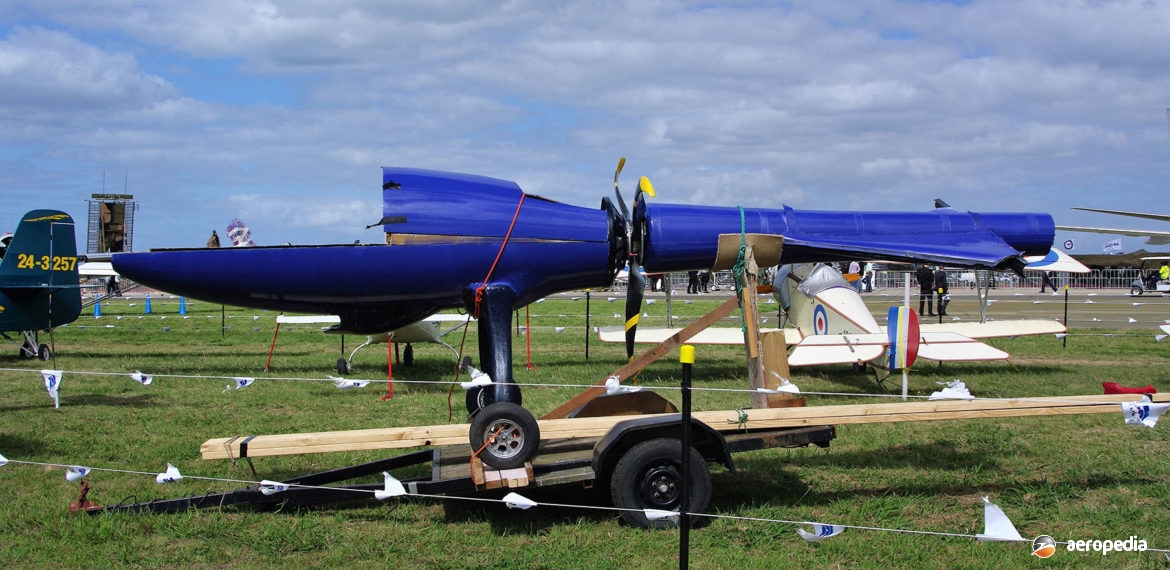Photograph:
Brand JBX-1 prototype at Avalon, VIC in March 2005 (David C Eyre)
Country of origin:
Australia
Description:
Single-seat high-performance ultralight aircraft
Power Plant:
One 18 kw (24 hp) Cuyuna 430 four-cycle air-cooled engine
Specifications:
- Wingspan (standard): 8.5 m (27 ft 9 in)
- Length: 6 m (19 ft 7 in)
- Wing area: 10.75 m² (115.71 sq m)
- Max speed: 110 km/h (68 mph)
- Stalling speed: 50 km/h (31 mph)
- Rate of climb: 152 m/min (500 ft/min)
- Service ceiling: 1,500 m (4,921 ft)
- Range: 500 km (311 miles)
- Take-off distance: 150 m (492 ft)
- Landing distance: 100 m (328 ft)
- Empty weight: 185 kg (408 lb)
- Payload weight: 115 kg (254 lb)
- Loaded weight: 300 kg (661 lb)
History:
The Brand JBX-1 was a new Australian designed ultralight single-seat high-performance sport aircraft designed, built and manufactured by Best Brand Aussie Aero of Camberwell, VIC, a company which produced the modular design aircraft which was described as like a 35 mm camera with interchangeable lenses. “…instead of changing lenses, you can change engines, wings, fuel tanks and propellers on the same basic airframe and get everything from a glider, to a speedy little airplane in one package”.
The type was marketed as an ultralight because of the growing worldwide market for low-cost, high-quality, energy-efficient ultralights. It was said that with a new specially developed composite propeller the thrust per horsepower was almost doubled, thus a 26 kw (35 hp) engine could replace a 48 kw (65 hp) unit. It was also said that at least 25 different combinations could be made using different modules, and the pusher propeller was more efficient and provided a smoother airflow over the tail surfaces with better rudder and elevator control. In the design the tailboom ran through the propeller, allowing a large diameter relatively slow-turning unit to be installed, thus producing more thrust, greater climb, and more speed from a given engine.
An ultralight aircraft, known as the Leaders AM-JB1 with a 23 kw (30 hp) Cuyuna 430 engine registered N212RB, used this propulsion system and won the most innovative design award at the 2002 Sun ‘n Fun Fly-in in Florida, USA. The pilot module, to which the seat was moulded, ws made of Kevlar to absorb stress.
This aircraft was manufactured by Brand Rolf of South Hill, Virginia and certification was issued on 21 October 1985. A further prototype was reported to have been completed in 2002 and development was proceeding.
A further prototype was planned, being described as a user-friendly, safe, fun aircraft with good flight characteristics, which could have a 75 kw (100 hp) two-cycle engine where the propulsion unit’s thrust would exceed the aircraft’s gross weight, giving it a 1G acceleration on take-off and allowing for “sustained vertical climb”.
The company, Best Brand Aussie-Aero, described the concept as revolutionary. It described the aircraft as a high-wing monoplane with a pusher propeller mounted around the tailboom. Being of modular concept the engine, wings, fuel tanks and propeller could be changed on the same basic airframe. It was to be marketed as an ultralight “because there is a growing worldwide market for low-cost, high-quality, energy-efficient ultralights”.
The prototype JBX-1, also described as the YB-2, was a single-seater and was first displayed to the aviation world at the Australian International Air Show at Avalon, VIC in 2005. In November 2006 the company entered into an agreement with GHD Studios Pty Ltd to manufacture a model known as the RB-1.

